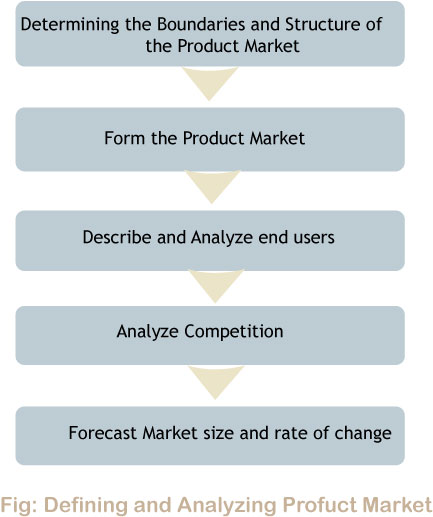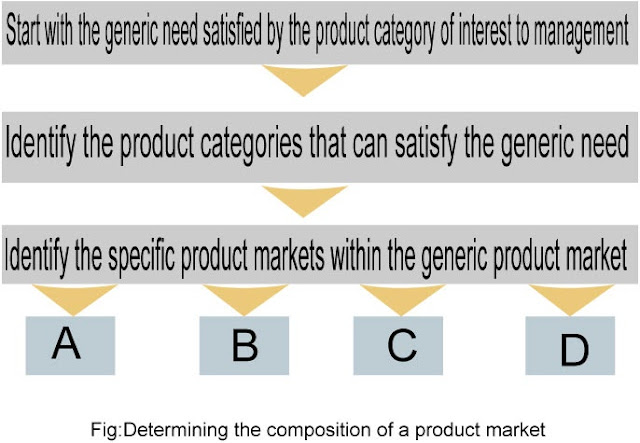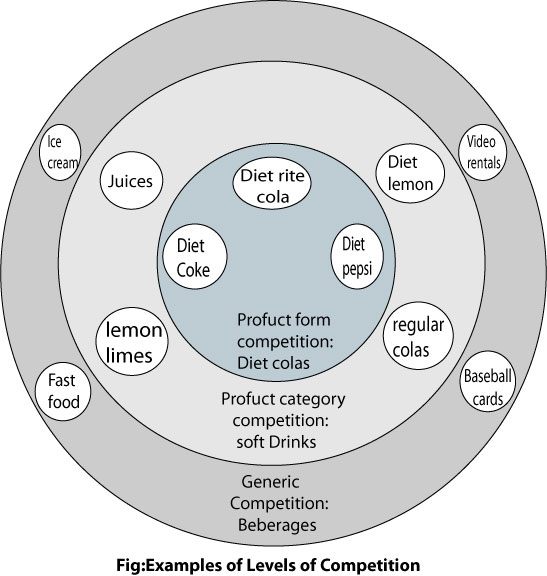1.Determining Product-Market Boundaries and Structure:
Product market consists of a specific product or line of related products that can satisfy a set of needs and wants for the people or organizations willing and able to purchase it.
a.Product market structure-
A company's brand competes with other companies brands in generic,product type and product variant product markets.
>Generic Product Market:
Generic product market includes a broad group of products that satisfy a general,yet similar need.
>Product type product market:
The product type product market includes all brands of a particular product type.
>Product variants product market:
Differences in the products within a product type product market may exist,creating product variants.
b.Guidelines for Definition-
In defining the product market,it is helpful to indicate the basis for identifying buyers in the product-market of interest,the market size and characteristics and the brand or product categories competing for the needs and wants of the buyers included in the product market.
The composition of a product market can be determined by following the steps.We illustrate how this process can be used to determine the composition of the kitchen appliance product market.Suppose top management of a kitchen appliance firm is considering expanding its mix of products.The company's present line of laundry and dish-washing product meets a generic need for the kitchen functions of cleaning.Other kitchen use situations include heating and cooling of foods.In this example the generic need is performing various kitchen functions.The products that provide kitchen functions are ways of satisfying the generic need.The break out of product into specific product market (A,B,C,D)would include equipment for washing and drying clothing,appliances for cooling food,cooking appliances, and dishwashers.Need identification is the basis for selecting the products that fit into the product market.
2.Forming Product Market:
The factors that influence how product market boundaries should be determined include the purpose for analyzing the product market,the rate of changes in market composition over time and the extent of market complexity.
a.Purpose of Analysis-
If management is deciding whether or not to exit from a business,primary emphasis may be on financial performance and competitive position.Detailed analysis of the product market may not be necessary.In contrast,if the objective is finding one or more attractive market segments to target in the product market,a much more penetrating analysis is necessary.
b.Changing Composition of Market-
As discussed earlier product market may change as new technologies become available and new competition emerges.New technologies offer buyers different ways of meeting their needs.
c.Extent of Market Complexity-
Three characteristics of markets capture a large portion of the variation in their complexity:
>The functions or users of the product needed by the customer
>The technology used in the product to provide the desired function
>The different customer segments using the product to perform a particular function.
3.Describing and Analyzing End Users:
After determining the product market structure it is useful to develop profiles of end user buyers for the generic,product type,and product variant levels of the product market.Buyers are identified,described,value requirements are indicated and environment influences determined.
a.Identifying and Describing Buyers-
Characteristics,such as family size,age,income,geographical location,sex and occupation are often useful in identifying buyers in consumer markets.Illustrative factors used to identify end users in organizational markets include type of industry,company size,location and types of products.Many published sources of information are available for use in identifying and describing customers.
b.How Buyers Make Choices-
Often,simply describing buyers does not provide enough information to guide market targeting and positioning decisions.We also need to try to find out why people buy products and specific product brands.In considering how customers decide what to buy,it is useful to analyze how they move through the sequence of steps leading to a decision to purchase a particular brand.Buyer normally follow a decision process.
c.Environmental Influences-
The final step in building customer profiles is to identify the external environmental factors that influence buyers and thus impact the size and composition of the market over time.These influences include government actions,social change,economic shifts,technology and other factors that may alter buyers needs and wants.Typically these factors are not controlled by the buyer or the firms that market the product and substantial changes in environmental influences can have a major impact on customers purchasing activities.
d.Building Customer Profiles-
Describing customers begins with the generic product market.At this level customer profiles are likely to describe the size and general composition of the customer base.For example the commercial air travel customer profile for a specified geographical area would include market size,growth rates,mix of business and pleasure travelers and other general characteristics.
4.Analyzing Competition:
Competitor analysis considers the companies and brands that compete in the product market of interest.Analyzing the competition follows the five steps
>defining the competitive area
>Identify key competitors
>Evaluate key competitors
>Anticipate actions by competitors
>Identify and evaluate potential competitors
a.Defining the Competitive Arena-
Competition often includes more than the firms that are direct competitors,like coke and pepsi. The product variant is the most direct type of competition.Nevertheless,other product categories of soft drinks also compete for buyers,as do other beverages.A complete understanding of the competitive arena helps to guide strategy strategy design and implementation.Since competition often occurs within specific industries,study of the industry structure is useful in defining the competitive arena,recognizing that more than one industry may be competing in the same product market,depending on the complexity of the product market structure.
> Industry Analysis:
Competitor analysis is conducted from the point of view of a particular firm.For example,a soft drink firm such as Coca-cola should include other beverage brands in its industry analysis.The industry analysis considers:
* Industry size,growth and composition.
* Typical marketing practices.
* Industry changes that are anticipated.
* Industry strengths and weaknesses.
* Strategic alliances and potential mergers.
> Analysis of the Value added chain:
The study of supplier and distribution channels is important in understanding and serving product markets.While some producers may go directly to their end users,many work with other organizations through distribution channels.
>Competitive Forces:
Different competitive forces are present in the value added chain.The traditional view of competition is expanded by recognizing Michael Porter's five competitive forces that impact industry performance-
< Rivalry among existing firms.
< Threat of new entrants.
< Threat of substitute products.
< Bargaining power of suppliers.
< Bargaining power of buyers.
b.Identify key competitors-
Key competitors are brands that compete in the same product market or segment.The rapid expansion of competitor intelligence activities by many companies in the last decade highlights the high priority executives place on monitoring competitors activities.
c.Evaluate Key Competitors-
A key competitor is any organization going after the same market target as the firm conducting the analysis.Key competitors are brands that compete in the same product market or segment within the market.Different product types that satisfy the same need or want may also actively compete against each other.
d.Anticipate Action by Competitors-
The information obtained in the previous steps of the analysis should be helpful in estimating future trends,although possible strategy shifts by competitors may occur.
e.Identify and Evaluate Potential Competitors-
New competitors may come from four major sources:
*companies competing in a related product market
*companies with related technologies
*companies already targeting similar customer groups with other products
*companies competing in other geographical regions with similar products.
5.Forecast Market Size and Rate of Change:
An important part of market opportunity analysis is estimating the present and potential size of the market.Market size is usually measured by dollar sales unit sales for a defined product market and specified time period.Three key measures of market size are :
a.Market Potential-
Market potential is the maximum amount of product sales that can be obtained from a defined product market during a specified time period.It includes the total opportunity for sales by all firms serving the product market.
b.Sales Forecast-
The sales forecast indicates the expected sales for a defined product market during a specified time period.The industry sales forecast is the total volume of sales expected by all firms serving the product market.
c.Market Share-
Company sales divided by the total sales of all firms for a specified product market determines the market share of a particular firm.Market share may be calculated on the basis of actual sales or foretasted sales.
<<<<<<<<<<---------->>>>>>>>>>



















0 Commentaries:
Post a Comment